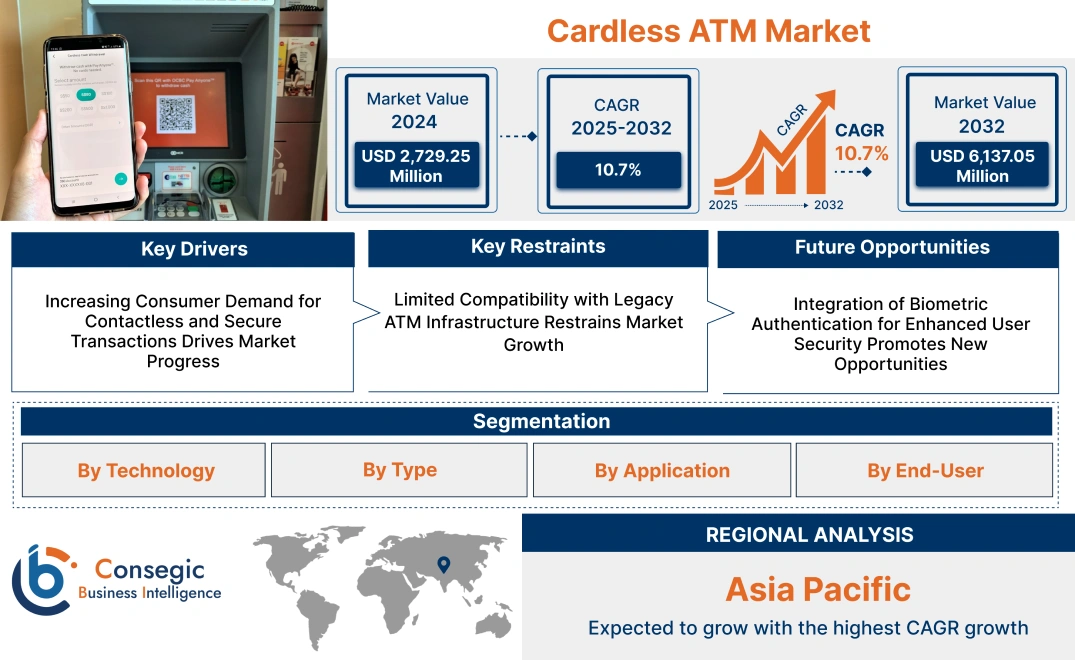- Summary
- Table Of Content
- Methodology
Cardless ATM Market Size:
Cardless ATM Market size is estimated to reach over USD 6,137.05 Million by 2032 from a value of USD 2,729.25 Million in 2024 and is projected to grow by USD 2,971.56 Million in 2025, growing at a CAGR of 10.70% from 2025 to 2032.
Cardless ATM Market Scope & Overview:
Cardless ATMs provide a convenient method for customers to withdraw cash or conduct transactions without using a physical debit or credit card. These ATMs rely on technologies such as mobile apps, QR codes, and biometric authentication to enable secure access. Users initiate transactions through their smartphones, which generate a unique authorization code or QR code for withdrawal at the ATM. This process not only enhances convenience but also reduces the risk of card skimming and other types of fraud. The use of cardless ATM technology spans across various financial institutions and banking networks, offering a seamless user experience while maintaining stringent security protocols. Cardless ATMs are typically integrated with mobile banking applications, allowing users to perform transactions such as cash withdrawals, balance inquiries, and fund transfers without physical cards. The technology also supports features like biometric verification, enhancing the security of transactions. End-users of this technology include banks, credit unions, and fintech companies that aim to offer enhanced digital banking services. The focus remains on providing secure, efficient, and user-friendly transaction methods, supporting the evolving needs of customers in the digital age.
Cardless ATM Market Dynamics - (DRO) :
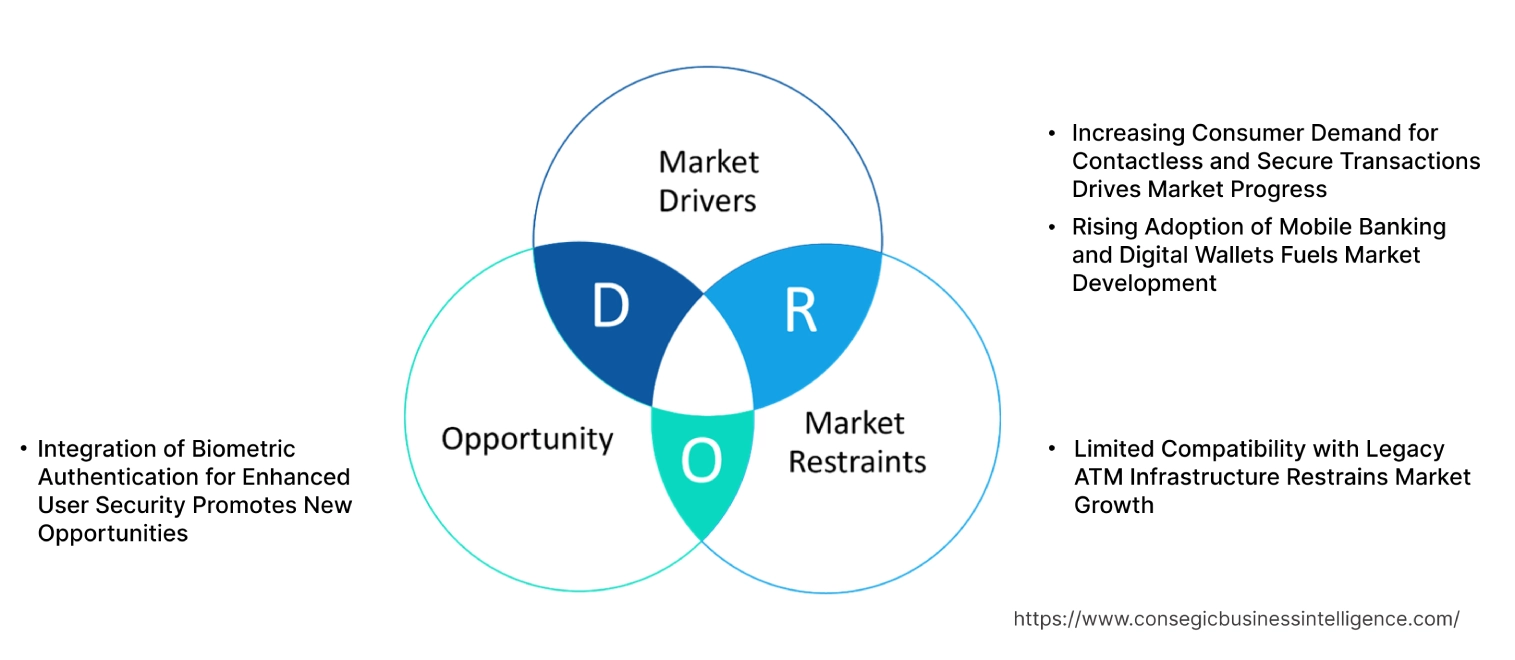
Key Drivers:
Increasing Consumer Demand for Contactless and Secure Transactions Drives Market Progress
The shift towards a digital-first approach, accelerated by the COVID-19 pandemic, has increased the demand for safer, more hygienic banking solutions. Cardless ATMs allow users to access cash using mobile apps, QR codes, or biometric authentication, eliminating the need for physical debit or credit cards. This method not only enhances the user experience by offering a convenient, contactless withdrawal process but also reduces the risk of card skimming and fraud. The adoption of contactless technologies in the ATM segment aligns with broader trends in digital payments and mobile banking, driving cardless ATM market growth, particularly in regions with high mobile payment penetration and tech-savvy consumers.
Rising Adoption of Mobile Banking and Digital Wallets Fuels Market Development
- The increasing use of mobile banking apps and digital wallets is propelling the growth of cardless ATM solutions. As consumers shift towards mobile-first banking experiences, financial institutions are integrating cardless withdrawal features directly into their mobile apps, allowing customers to initiate transactions remotely and complete them at an ATM without using a physical card. Digital wallet providers like Apple Pay, Google Pay, and Samsung Pay are also offering integrated cardless ATM access, enabling users to withdraw cash securely using Near Field Communication (NFC) technology. This trend is particularly strong among younger, tech-savvy users who prefer the convenience of managing their finances entirely through mobile devices. The integration with mobile banking apps and digital wallets enhances customer engagement, drives app usage, and offers a seamless, unified banking experience. Therefore, the expansion of mobile banking and digital wallets is fueling the cardless ATM market demand.
Key Restraints :
Limited Compatibility with Legacy ATM Infrastructure Restrains Market Growth
Many financial institutions still operate traditional ATMs that lack the necessary software and hardware upgrades to support cardless transactions, such as NFC readers, QR code scanners, or mobile app integrations. Upgrading or replacing legacy ATMs requires substantial investment, particularly for banks with extensive ATM networks. Additionally, ensuring that cardless features work seamlessly across different ATM models and vendors is technically challenging, increasing the complexity of deployment. The high cost and logistical constraints associated with modernizing ATM fleets may deter some banks from fully implementing cardless capabilities, particularly in regions with older ATM networks or limited IT budgets, hampering the cardless ATM market expansion.
Future Opportunities :
Integration of Biometric Authentication for Enhanced User Security Promotes New Opportunities
The integration of biometric authentication technologies such as fingerprint scanning, facial recognition, and voice recognition into cardless ATM services presents a significant opportunity for enhancing user security and convenience. Biometric authentication provides an additional layer of security by verifying the user's identity based on unique physical characteristics, reducing the risk of unauthorized access and fraudulent transactions. By incorporating biometric features into mobile banking apps and ATM interfaces, financial institutions offer a seamless, secure cardless experience that meets growing consumer expectations for advanced security measures. The adoption of biometric technologies solutions is gaining traction, especially in markets where digital identity and authentication systems are well-established, offering banks a way to differentiate their services and attract security-conscious customers. Thus, the aforementioned factors fuel the cardless ATM market opportunities.
Cardless ATM Market Segmental Analysis :
By Technology:
Based on technology, the market is segmented into QR Code-Based, NFC (Near-Field Communication), Biometric Authentication, and Mobile App-Based solutions.
The QR Code-Based segment accounted for the largest revenue of the total cardless ATM market share in 2024.
- QR Code-Based technology allows users to scan a code generated on their mobile banking app to initiate transactions, offering a secure and contactless method for accessing cash.
- This method is gaining popularity due to its simplicity, widespread smartphone adoption, and minimal need for specialized hardware upgrades at ATM locations.
- Leading financial institutions are integrating QR Code-Based solutions into their mobile banking apps to provide a seamless customer experience.
- The strong demand for contactless transactions, driven by the COVID-19 pandemic and increased focus on hygiene, has contributed to the development of the QR Code-Based segment.
- As per cardless ATM market analysis, the dominance of the QR Code-Based segment is attributed to its ease of use, security features, and compatibility with existing mobile banking apps.
The NFC segment is expected to register the fastest CAGR during the forecast period.
- NFC (Near-Field Communication) technology enables users to initiate transactions by tapping their smartphones or NFC-enabled devices at ATMs, offering a fast and convenient way to withdraw cash without a card.
- This technology provides enhanced security as it requires proximity and user authentication via the mobile device, reducing the risk of unauthorized access.
- Financial institutions are increasingly adopting NFC-based solutions to enhance customer convenience and meet the growing need for contactless payment methods.
- The rising adoption of NFC-enabled smartphones and the push towards contactless transactions are driving the rapid extension of this segment.
- The NFC segment is projected to grow rapidly due to its secure, fast, and user-friendly transaction process, which further facilitates the cardless ATM market growth.
By Type:
Based on type, the market is segmented into On-Site ATM, Off-Site ATM, and Others.
The On-Site ATM segment accounted for the largest revenue of 59.03% of the total cardless ATM market share in 2024.
- On-site ATMs, located within bank branches, provide added security and convenience for customers, making them a preferred choice for many financial institutions.
- These ATMs offer additional services beyond cash withdrawal, such as account inquiries, fund transfers, and bill payments, enhancing their value proposition.
- The presence of bank staff at on-site locations further enhances customer confidence in using cardless ATM transactions, particularly for new or unfamiliar technologies.
- The strong preference for secure, reliable ATM services within bank premises drives the dominance of the On-Site ATM segment.
- As per cardless ATM market trends, the On-Site ATM segment leads the market due to its comprehensive service offerings, enhanced security, and strong customer trust.
The Off-Site ATM segment is expected to register the fastest CAGR during the forecast period.
- Off-site ATMs are standalone machines located in high-traffic areas such as shopping malls, airports, and retail centers, providing greater accessibility to customers.
- These ATMs offer the convenience of 24/7 access, catering to customers who may not have easy access to a bank branch.
- The growing adoption of cardless ATM solutions by independent ATM deployers (IADs) is contributing to the enlargement of Off-Site ATMs, as they look to offer advanced features to attract more users.
- The increasing emphasis on expanding ATM networks in remote and underserved areas is further driving the growth of the Off-Site ATM segment.
- The Off-Site ATM segment is expected to grow rapidly, supported by its wide availability, customer convenience, and the extension of independent ATM networks further driving the cardless ATM market demand.
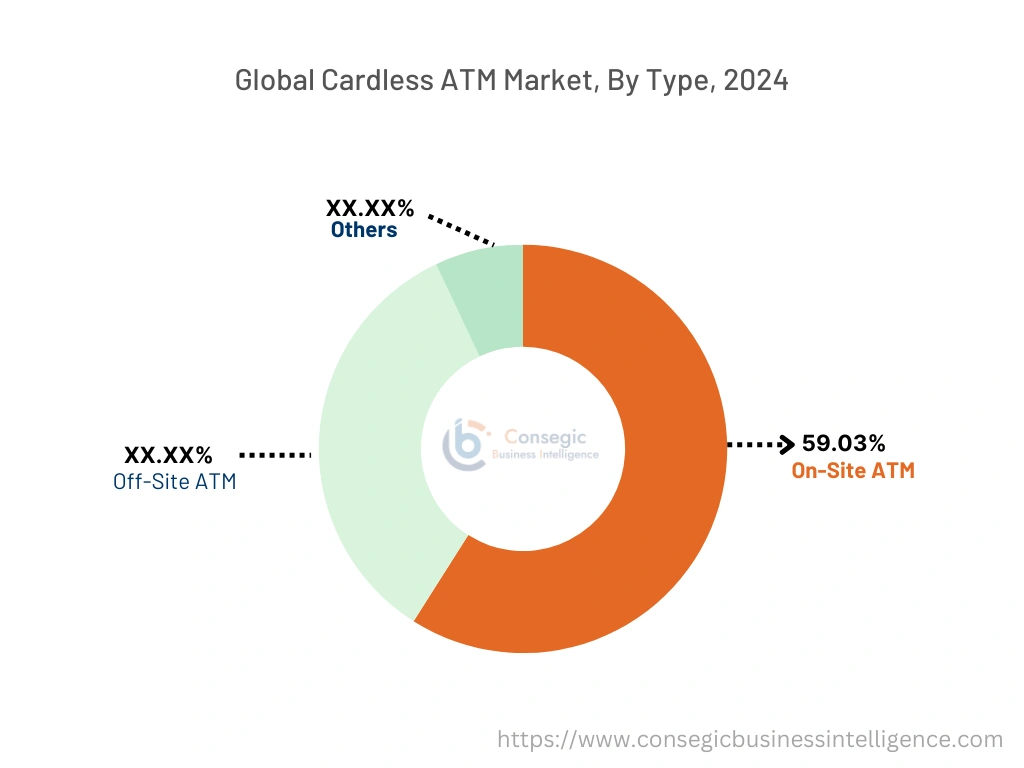
By Application:
Based on application, the market is segmented into personal banking, corporate banking, retail payments, and others.
The Personal Banking segment accounted for the largest revenue share in 2024.
- Cardless ATM solutions in personal banking offer enhanced convenience and security, allowing customers to withdraw cash, check balances, and perform other transactions without a physical debit card.
- This application is highly popular among tech-savvy consumers who prefer using mobile banking apps for a seamless, card-free experience.
- Financial institutions are focusing on integrating cardless features into their mobile banking apps to meet the growing need for secure and convenient personal banking services.
- The increased use of smartphones and mobile banking apps is driving the adoption of cardless ATM solutions in personal banking, enhancing user experience and satisfaction.
- As per cardless ATM market analysis, the dominance of the personal banking segment is due to its widespread use, user preference for mobile-based transactions, and the increasing focus on secure, cardless banking options.
The Retail Payments segment is projected to register the fastest CAGR during the forecast period.
- Retail payments via cardless ATMs allow consumers to complete transactions at retail locations without the need for a physical card, using mobile apps or digital wallets instead.
- This application provides a convenient option for customers who prefer contactless payment methods, reducing the need for carrying physical cards and enhancing payment security.
- The rise of digital wallets and mobile payment platforms, such as Apple Pay and Google Pay, is driving the adoption of cardless ATM solutions in retail settings.
- Retailers benefit from faster checkout processes and reduced fraud risk, as cardless transactions rely on secure mobile authentication methods.
- As per cardless ATM market trends, the retail payments segment is expected to grow rapidly, driven by the increasing adoption of mobile payments, the shift towards a cashless economy, and the demand for faster, more secure payment options.
By End-User:
Based on end-user, the market is segmented into Banks & Financial Institutions, Independent ATM Deployers (IADs), and others.
The Banks & Financial Institutions segment accounted for the largest revenue share in 2024.
- Banks and financial institutions are the primary adopters of cardless ATM solutions, as they focus on enhancing customer experience and offering secure, contactless transaction options.
- Cardless ATM services help banks reduce the risk of card skimming and fraud, as transactions are initiated via mobile apps, eliminating the need for a physical card.
- Leading banks are integrating cardless features into their digital banking platforms, providing customers with seamless access to cash and other banking services through their smartphones.
- The strong push towards digital transformation and the growing adoption of mobile banking is driving the widespread implementation of cardless ATM solutions in this segment.
- The dominance of banks & financial institutions is attributed to their extensive ATM networks, focus on security, and commitment to providing innovative, customer-centric services which further fuels the cardless ATM market expansion.
The Independent ATM Deployers (IADs) segment is expected to register the fastest CAGR during the forecast period.
- Independent ATM Deployers (IADs) are increasingly adopting cardless ATM technologies to differentiate their services, attract more users, and compete effectively with traditional bank ATMs.
- IADs focus on deploying cardless-enabled ATMs in high-traffic locations such as shopping centers, convenience stores, and transportation hubs, catering to a wide range of customers seeking quick and secure access to cash.
- The flexibility of IADs in integrating new features and technologies allows them to rapidly adapt to market trends and meet the growing need for innovative ATM services.
- The rising trend of outsourcing ATM services by banks to IADs is further driving the adoption of cardless ATM solutions in this segment.
- The rapid growth of the IADs segment is driven by their agility, focus on customer convenience, and strategic placement of ATMs in inaccessible, high-footfall areas.
Regional Analysis:
The regions covered are North America, Europe, Asia Pacific, the Middle East and Africa, and Latin America.
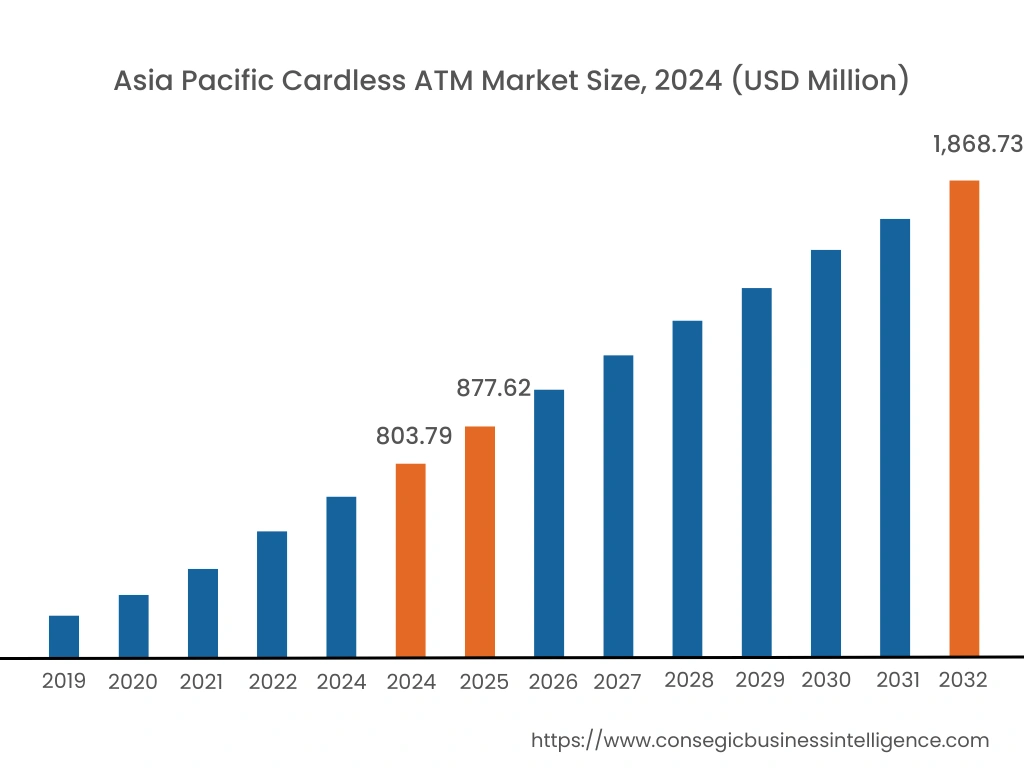
Asia Pacific region was valued at USD 803.79 Million in 2024. Moreover, it is projected to grow by USD 877.62 Million in 2025 and reach over USD 1,868.73 Million by 2032. Out of these, China accounted for the largest share of 35.9% in 2024. Asia-Pacific is witnessing the fastest growth in the market, driven by increasing digital adoption, rising mobile banking usage, and expanding financial inclusion efforts in countries like China, India, and Japan. In China, tech giants such as Alipay and WeChat Pay have popularized QR code-based withdrawals, while India's focus on digital banking initiatives has boosted the deployment of cardless ATM solutions across urban and rural areas. Japan's strong technology infrastructure also supports market expansion.
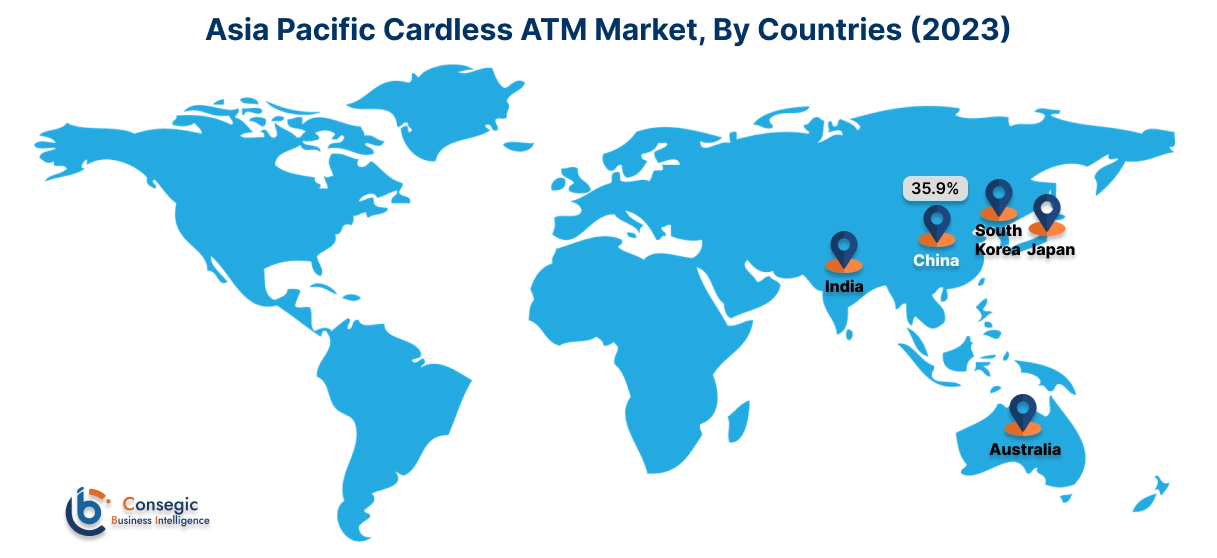
North America is estimated to reach over USD 1,989.02 Million by 2032 from a value of USD 905.32 Million in 2024 and is projected to grow by USD 983.81 Million in 2025. North America commands a significant share of the market, bolstered by widespread adoption of mobile banking solutions and a strong focus on enhancing customer convenience. The U.S. is at the forefront of this trend, with major banks like Bank of America, Wells Fargo, and JPMorgan Chase integrating cardless ATM services to cater to tech-savvy consumers. The shift toward contactless transactions, accelerated by the COVID-19 pandemic, has further fueled cardless ATM market opportunities.
Europe is a key market for cardless ATMs, with strong uptake observed in countries such as Germany, the UK, and Spain. The region's focus on digital banking innovation, coupled with high smartphone penetration, drives the demand for cardless ATM services. European banks are leveraging QR code-based and near-field communication (NFC) technologies to provide secure, seamless withdrawal experiences. Regulatory requirements, such as those mandated by PSD2 (Payment Services Directive 2), ensure enhanced security in these services.
The Middle East & Africa region shows promising growth in the market, particularly in the UAE, Saudi Arabia, and South Africa. The adoption of cardless ATM solutions is being driven by a push toward digital banking transformation and enhanced financial services as part of broader government initiatives like Saudi Arabia's Vision 2030. Banks in the UAE are rapidly implementing cardless withdrawal features to offer enhanced security and convenience to customers.
Latin America is an emerging market for cardless ATMs, with Brazil and Mexico leading the way. The rising need for digital banking services, driven by a young, tech-savvy population and increasing smartphone usage, is supporting market progress. Brazil's financial institutions are pioneering mobile-based ATM withdrawals to reduce card dependency and curb fraud. Mexico's efforts to enhance financial inclusion and modernize banking services further contribute to the adoption of cardless ATM technology.
Top Key Players & Market Share Insights:
The Cardless ATM market is highly competitive with major players providing products and services to the national and international markets. Key players are adopting several strategies in research and development (R&D), product innovation, and end-user launches to hold a strong position in the global Cardless ATM market. Key players in the Cardless ATM industry include –
- Citigroup Inc. (USA)
- JPMorgan Chase & Co. (USA)
- Wells Fargo & Company (USA)
- NCR Corporation (USA)
- Fujitsu Limited (Japan)
- GRG Banking (China)
- ICICI Bank Ltd. (India)
- Santander Group (Spain)
- Barclays PLC (UK)
- HSBC Holdings plc (UK)
Recent Industry Developments :
Product Launches:
- In June 2023, the Bank of Baroda introduced a new ICCW (Integrated Cardless Cash Withdrawal) facility at its ATMs using UPI. This innovation allows customers to withdraw cash from ATMs without using a physical debit or credit card. Instead, users can simply use their mobile phones and UPI for secure, cardless transactions. This service is aimed at providing enhanced convenience and security to users.
- In January 2023, Fidelity Bank launched a cardless ATM withdrawal feature, allowing customers to access their funds securely without the need for a physical ATM card. This service uses a secure code sent to customer's mobile devices to complete transactions, offering added convenience and security for users. The new feature aims to streamline access to banking services, especially for those who may not have their bank cards readily available.
Cardless ATM Market Report Insights :
| Report Attributes | Report Details |
| Study Timeline | 2019-2032 |
| Market Size in 2032 | USD 6,137.05 Million |
| CAGR (2025-2032) | 10.7% |
| By Technology |
|
| By Type |
|
| By Application |
|
| By End-User |
|
| By Region |
|
| Key Players |
|
| North America | U.S. Canada Mexico |
| Europe | U.K. Germany France Spain Italy Russia Benelux Rest of Europe |
| APAC | China South Korea Japan India Australia ASEAN Rest of Asia-Pacific |
| Middle East and Africa | GCC Turkey South Africa Rest of MEA |
| LATAM | Brazil Argentina Chile Rest of LATAM |
| Report Coverage |
|
Key Questions Answered in the Report
How big is the Cardless ATM market? +
Cardless ATM Market size is estimated to reach over USD 6,137.05 Million by 2032 from a value of USD 2,729.25 Million in 2024 and is projected to grow by USD 2,971.56 Million in 2025, growing at a CAGR of 10.70% from 2025 to 2032.
What specific segmentation details are covered in the Cardless ATM Market report? +
The Cardless ATM market report includes segmentation details for technology (QR Code-Based, NFC, Biometric Authentication, Mobile App-Based), type (On-Site ATM, Off-Site ATM, Others), application (Personal Banking, Corporate Banking, Retail Payments, Others), end-user (Banks & Financial Institutions, Independent ATM Deployers, Others), and region.
Which is the fastest-growing technology in the Cardless ATM market? +
The NFC (Near-Field Communication) technology segment is expected to register the fastest CAGR during the forecast period, driven by its secure, fast, and user-friendly transaction process.
Who are the major players in the Cardless ATM market? +
The major players in the Cardless ATM market include Citigroup Inc. (USA), JPMorgan Chase & Co. (USA), Wells Fargo & Company (USA), NCR Corporation (USA), Fujitsu Limited (Japan), GRG Banking (China), ICICI Bank Ltd. (India), Santander Group (Spain), Barclays PLC (UK), and HSBC Holdings plc (UK).
